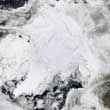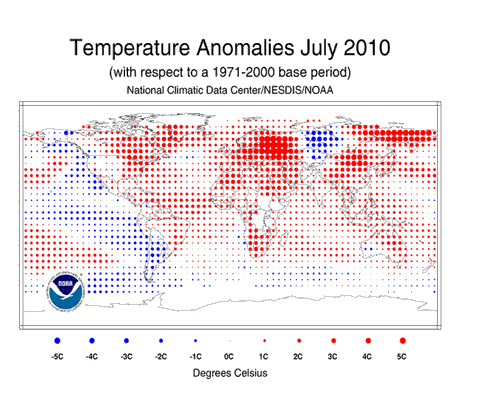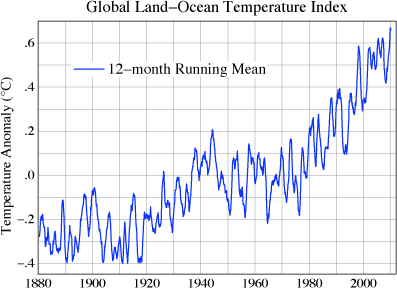
Last week NOAA released the 2010 update of its Arctic Report Card, covering the 2009/10 winter season and 2010 summer sea ice minimum. It makes for sobering reading. Greenland experienced record high temperatures, ice melt and glacier area loss, sea ice extent was the third lowest in the satellite record, and Arctic snow cover duration was at a record minimum. It’s worth digging through the whole report — it’s concise, well illustrated and referenced back to the underlying research — but a couple of things struck me as really important.
The first is the dramatic melting seen in Greenland this summer. From the Greenland report card:
Summer seasonal average (June-August) air temperatures around Greenland were 0.6 to 2.4°C above the 1971-2000 baseline and were highest in the west. A combination of a warm and dry 2009-2010 winter and the very warm summer resulted in the highest melt rate since at least 1958 and an area and duration of ice sheet melting that was above any previous year on record since at least 1978.
And…
Abnormal melt duration was concentrated along the western ice sheet (Figure GL3), consistent with anomalous warm air inflow during the summer (Figure GL1) and abnormally high winter air temperatures which led to warm pre-melt conditions. The melt duration was as much as 50 days greater than average in areas of west Greenland that had an elevation between 1200 and 2400 meters above sea level. In May, areas at low elevation along the west coast of the ice sheet melted up to about 15 days longer than the average. NCEP/NCAR Reanalysis data suggest that May surface temperatures were up to 5°C above the 1971–2000 baseline average. June and August also exhibited large positive melting day anomalies (up to 20 days) along the western and southern ice sheet. During August temperatures were 3°C above the average over most of the ice sheet, with the exception of the northeastern ice sheet. Along the southwestern ice sheet, the number of melting days in August has increased by 24 days over the past 30 years.
Not good news for the ice sheet. The atmosphere report card draws attention to the impact Arctic warming is having further south, dubbing it the warm arctic/cold continents pattern (WACC).
While 2009 showed a slowdown in the rate of annual air temperature increases in the Arctic, the first half of 2010 shows a near record pace with monthly anomalies of over 4°C in northern Canada. There continues to be significant excess heat storage in the Arctic Ocean at the end of summer due to continued near-record sea ice loss. There is evidence that the effect of higher air temperatures in the lower Arctic atmosphere in fall is contributing to changes in the atmospheric circulation in both the Arctic and northern mid-latitudes. Winter 2009-2010 showed a new connectivity between mid-latitude extreme cold and snowy weather events and changes in the wind patterns of the Arctic; the so-called Warm Arctic-Cold Continents pattern.
So now you know where the WACCy winter weather’s coming from…

 A few days ago I used a combination of Arctic sea ice volume data from the University of Washington’s PIOMAS model and NSIDC sea ice extent numbers to
A few days ago I used a combination of Arctic sea ice volume data from the University of Washington’s PIOMAS model and NSIDC sea ice extent numbers to  The
The 

